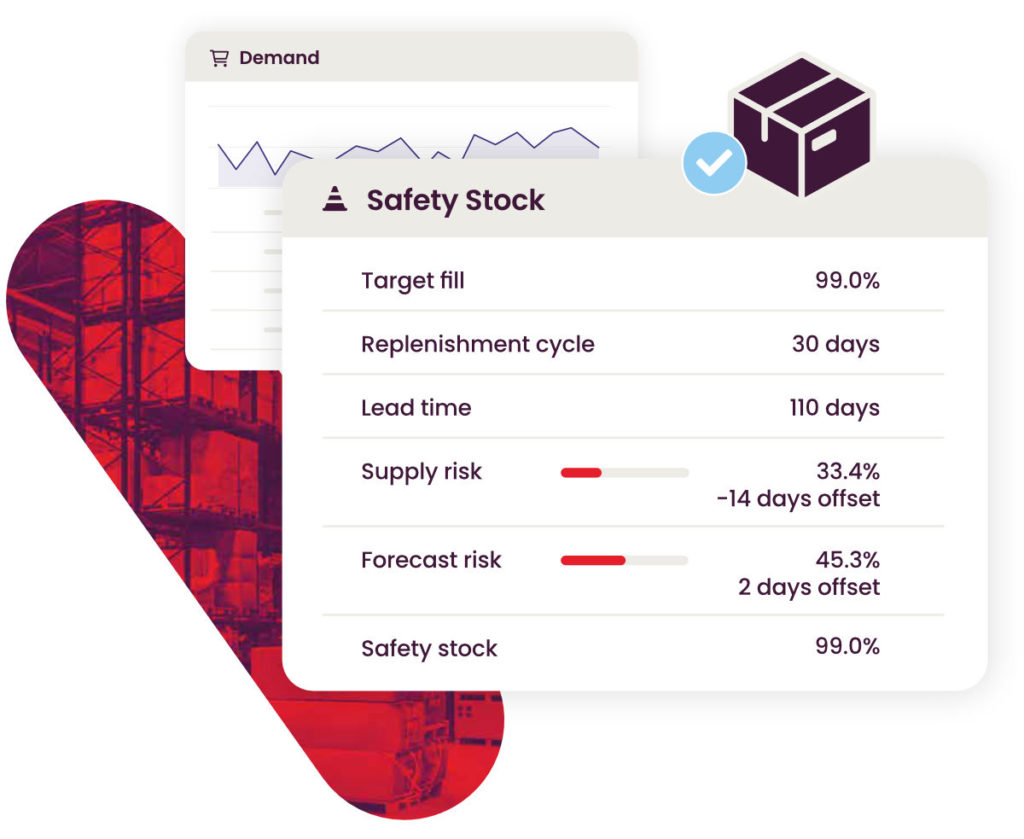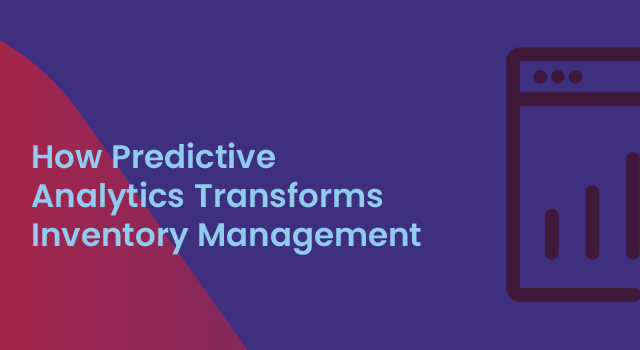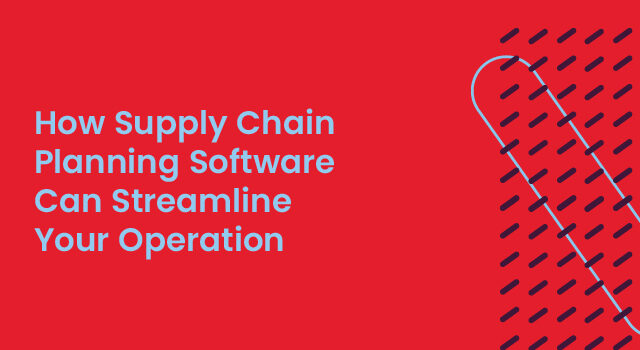Safety stock is essential in your supply chain, helping you avoid stock-outs and stay on top of demand. But how much is just the right amount?
Managing stock is a tricky balancing act. Too much ties up cash, but too little means you’re scrambling to meet demand. What happens if demand spikes unexpectedly or your supplier drops the ball? Running out of key items is the last thing you want. Can your business really afford that risk?
Stock-outs aren’t just a hassle—they can cost you more than a sale. You could lose a loyal customer. With supply chain disruptions and fluctuating customer needs, you need a backup plan. That’s where safety stock comes in.
In this guide we’ll explore:
- What is safety stock?
- Why does your business need safety stock?
- What happens when you experience stock-outs?
- What inputs to consider when selecting safety stock levels.
- Your inventory policy and safety stock
- What factors to consider when identifying safety stock?
- The impact of having too much safety stock
1 What is safety stock?
Simply put, safety stock is the extra buffer you keep on hand to avoid stock-outs and ensure you can meet demand. It’s your backup when you’re nearing the end of your replenishment cycle. The tricky part? Figuring out the right amount of safety stock for each item. And here’s the thing—you don’t need safety stock for everything!
Now, calculating the right amount of safety stock can be tricky, but don’t worry—there’s a formula for that! It’s all about balancing demand and supply to find that sweet spot. Want to dive into the details and get it just right? Check out our guide on how to calculate safety stock here.
2 Why does your business need safety stock?
Safety stock is all about making sure your customers always get the products they want, when they want them. It sounds simple, but there are a couple of things to consider before you calculate just how much you need.
First: consider whether your customers’ preferences are predictable or unpredictable. Items that are tough to forecast will need more safety stock. Items with more predictable demand are easier to forecast, so they’ll need less.
Second: delivery timing matters. If your items arrive late, you’ll need extra safety stock. If they show up early, you can hold less.
Getting your safety stock right helps your business:
- Mitigate the risk of stock-outs
- Maintain ongoing customer loyalty
- Improve your sales
The two big risks safety stock protects you from
Safety stock is like a safety net, protecting you from two big inventory risks:
- Forecast risk: Your customer’s needs can be unpredictable, and forecasts aren’t always spot-on.
- Supply risk: Suppliers sometimes face disruptions, so deliveries might not be on time or in full.
The ripple effect of a stock-out
If you’re a retailer or distributor and you don’t have the stock a customer ordered, what happens next?
- Why have you stocked out? Maybe demand was higher than expected, or you didn’t factor in the right amount of safety stock when you ordered.
- How does your customer react? They’re frustrated and might think twice before buying from you again.
- What happens to your sales? If the customer won’t wait, you lose that sale—and possibly future ones too.
3 What happens when you experience stock-outs?
Without customers, your business doesn’t stand a chance. In today’s fast-paced, competitive world, consumers expect instant gratification and clear communication about the status of their orders—no matter what industry you’re in.
Stock-outs also affect your internal processes. Your team will often spend additional hours trying to establish why you are stocking out on certain products. As a solution to running out of stock, inventory planners will usually have to:
- Place emergency orders on their suppliers.
- Select a faster, less cost-effective delivery option. [for example, using air freight]
- To keep the customer happy, buy the product from a competitor – even if it means selling the product at a loss!
What does it all mean for your business?
To reduce the impact of stock-outs, you need clear visibility into your inventory. Using an inventory management solution with a single-view dashboard that monitors KPIS—like which items are about to run out before your next delivery—lets you take action fast, so you can meet demand without unnecessary costs.
Netstock recognizes that you can’t look at every single item every day, so it focuses on the most important items. The dashboard gives you a high-level view of total stock holding, excess stock, stock-outs, and potential stock-outs. We can quickly see where the pain points are and what action we need to take – Crazy Aaron Enterprises, Inc, USA.
When you experience a stock-out, your customer will typically do one of the following:
- If they still want the same brand, they might search for another supplier who has it
- They might switch to a completely different brand
- If they’re loyal to your brand, they want a different model, size, or color
- If they’re passionate about your brand and not in a rush, they might wait for the stock to come back
But here’s the thing—there’s a tipping point. Customers won’t wait forever. They’ll switch brands if the stock-out drags on.
For online shoppers, a stock-out can mean abandoned carts—along with everything else they had in there. You could lose the whole basket of products they were ready to buy.
4 What inputs to consider when calculating your safety stock levels?
A “one-size-fits-all” approach to safety stock is a recipe for stock-outs on some items and excess stock on others. So, how do you set the right safety stock levels for each product?
Besides your target fill rate, here are the other key factors that affect your safety stock calculation:
-
- Forecast: The more accurate your forecast, the better. Sales teams can provide valuable market insights from top customers. Under-forecasting? That means more safety stock to cover the gap.
- Replenishment cycle: How often and how much you buy matters. The shorter the cycle (think frequent, small deliveries), the more safety stock you might need.
- Lead time: The longer it takes for your stock to arrive after placing the order, the more safety stock you’ll likely need.
- Forecast risk: Since forecasts aren’t always perfect, safety stock acts as a buffer for inaccuracies.
- Supply risk: Suppliers aren’t always 100% reliable. If they deliver late, you’ll need extra safety stock to keep your promises to customers.
A snapshot of how the Netstock app automatically calculates safety stock.
When setting the safety stock level for each line item, consider the following:
- The desired or target availability (service) level
- The accuracy with which the item is being forecasted
- Length of lead time
- The reliability and accuracy of the lead time
- The inventory replenishment cycle
- The review cycle [The frequency in which items are reviewed for ordering purposes.]
- The service lag time [Is the item required to be “on the shelf,” or is 48-hour delivery acceptable?]
5 Your inventory policy and safety stock
An inventory policy helps you manage your inventory effectively by balancing your working capital with the service levels you want to offer your customers—your target fill rate. Here’s how it works:
- It sets the boundaries for managing inventory: Your policy provides the framework for determining stock levels.
- Factor in supply and demand risks: For each item, you’ll need to consider the risks and the safety stock levels.
- Find the balance between service and savings: You can offer better service and save money by investing in the right stock and cutting back on less important items.
- Safety stock plays a key role: Carrying more safety stock can improve your service levels, but it ties up more cash in your warehouse. Less safety stock improves cash flow but could lower service levels.
An effective inventory policy is all about balancing cash flow and meeting customer needs.
6 What factors to consider when identifying safety stock.
You’ve got hundreds, maybe even thousands, of SKUs in your warehouse—and not every item has the same demand. Some are more critical to your business than others. That’s why it’s important to classify your inventory. When you do, you can identify:
- Obsolete items: Items you no longer plan to stock.
- Non-stocked items: Items you only order when requested.
- Stocked items: Your active inventory.
Using an ABC analysis to classify your stocked items helps you focus on what really matters. It ranks items based on their importance and how fast they sell, giving you a clear picture of which ones might need safety stock. If you’ve got high-value, fast-moving items with unpredictable demand, you’ll likely need more safety stock to keep up.
What does this mean for your business? By classifying your inventory, you can invest your money in the items that matter most—and pull back from the ones that don’t.
Know your supplier’s history
Know your suppliers and analyze their delivery history. Review how often your suppliers deliver in full or only part and remove any irregularities that could skew the results. For example, the items air freighted in on special orders or orders with an unexpected delay.
Have accurate sales and previous forecast history
Analyze your sales history against your previous forecasts to determine your level of accuracy and predictability. Don’t only look at the last month’s data as the purchase decision is often made months ahead of that. Measure from when you had stock of the item to sell rather than when the product was added to the master list. Take any staff or computer overrides into your forecast measurement into account, as it’s the combination that results in what you end up purchasing. Consider the stock item’s risk profile and the forecast accuracy to give you the safety stock you need to act as a buffer and help your sales team.
Review target fill rate
Your fill rate refers to the percentage of customer demand you can meet with your current stock on hand without placing backorders or missing a sale. To buffer against potential uncertainties or disruptions, you would need an infinite amount of stock that most businesses are unlikely to afford. It would also be challenging to find space to store all this inventory. When determining your safety stock level, it doesn’t help to use a fixed quantity either. This may result in being overstocked during part of the year and under-stocked at other times. Good inventory planning requires the ability to apply dynamic values.
Always review your safety stock levels because your risks change regularly. Your forecasts change, your supplier’s risk changes and your business objectives change.
7 The impact of having too much safety stock.
Ordering too much safety stock can leave you with excess inventory in your warehouse. And excess stock isn’t just sitting there—it costs your business money. You’ll need extra resources for things like:
- Storage space
- Insurance
- Labor and admin
- Potential loss from damage or theft
In today’s complex world, planning your inventory effectively requires the right tools.
To know what stock to order, you first need to understand what you’re planning to sell. With the supply chain constantly shifting, relying on spreadsheets for planning and replenishment can put your business at risk.
Considering the many variables in calculating safety stock, are you confident you can meet demand, avoid stock-outs, and keep sales flowing?
Investing in an inventory and demand planning solution like Netstock gives you the visibility to:
- Create accurate forecasts
- Get smart order recommendations
- Calculate the right safety stock levels for each item
The magic of Netstock: Your safety stock is based on each item’s classification. If your supplier’s reliability drops, supply risk automatically increases, and Netstock adjusts your safety stock levels accordingly—simple and accurate.





